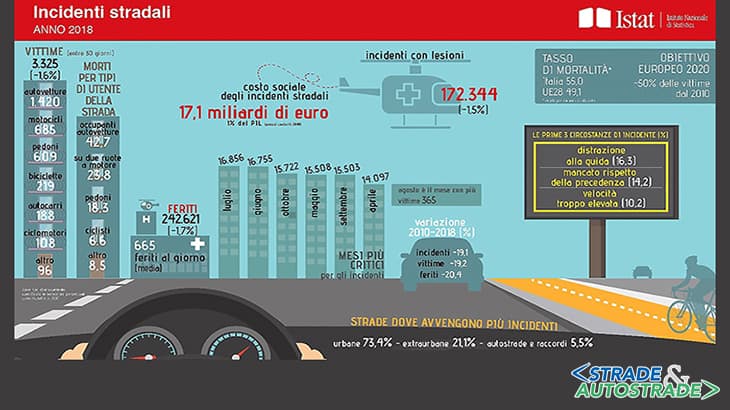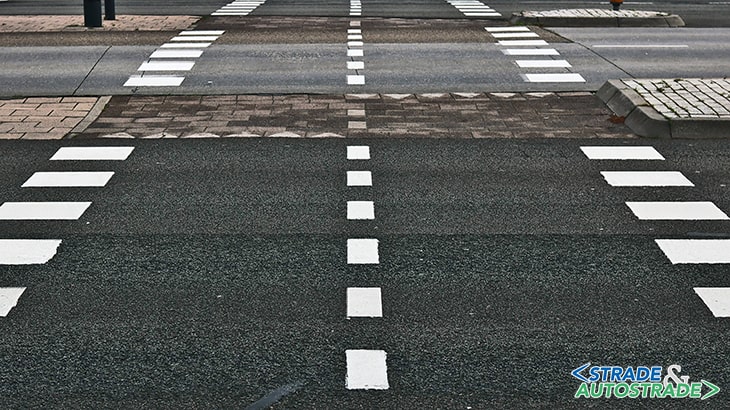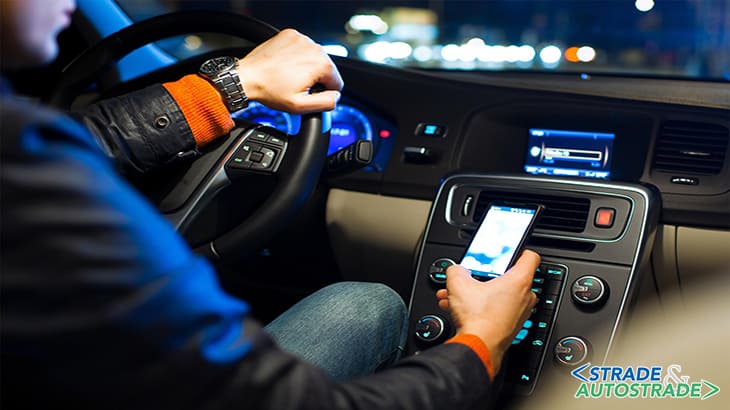Road accidents and supporting technologies to reduce them ![]() Per la versione in Italiano: https://www.stradeeautostrade.it/its-smart-road/lincidentalita-stradale-e-le-tecnologie-a-supporto-per-ridurla/
Per la versione in Italiano: https://www.stradeeautostrade.it/its-smart-road/lincidentalita-stradale-e-le-tecnologie-a-supporto-per-ridurla/
After a thorough analysis of the types of road accidents and their relative consequences, I wrote this article aiming to illustrate how it is possible to go deep by adopting dedicated devices which will allow both to avoid accidents and to limit the possibility of users to do something that may increase the likelihood of an accident while driving.
When the cause of the accident and its seriousness are attributable to “the behaviour of the driver”, technology can intervene in an effective and efficient way as an “assistant” for the driver. Nowadays, accidents caused by incorrect driving behaviours account for 80-90% of the total amount, and as it has been proved, the increasing of penalties do not lead to satisfactory results in reducing the accidents.
This has been one of the great issues that concerns Italy as well as many other countries and a concern which we must start to address. More than ever, it is an urgent need to modify the Highway Code so that these devices can be employed.
On this point, we would also like to highlight the serious delay we are experiencing. Nevertheless, it is necessary to mention that in the coming years, European Union will make the employment of nearly thirty devices compulsory in order to reduce the number of accidents.
However, it does not seem like a priority. It is important to remark that some of these technological innovations will take years to be effective, therefore we cannot expect that everything will work perfectly as soon as we adopt this new measure.

In fact, some of the systems, which can only be installed by the vehicle manufacturers, will be introduced to market with a delay of at least 3-5 years so the manufacturers can modify and adapt the assembly lines.
It is necessary that at least 50%, if not more, of the vehicles in circulation are provided with innovative solutions before they can have an effective result, hence another five years. Still, all this seems to be something negligible… while the number of accidents, people killed or injured on the roads is continuously increasing.
The italian situation for road accident
Considering the situation of accidents on the roads in Italy drawn up by Istat, it shows that in 2018 there were 172.553 road accidents with physical injuries, -1,4% down when compared to 2017; with 3.334 victims (died within 30 days from the event) and 242.919 injuries (-1,6%).
The drop in the number of deaths caused by road accidents in 2018 raised some hope, however the data of the first nine months in 2019 were alarming: the number of victims increased by 7%.
Unfortunately, if continuing with this pace, it is likely that the ambitious purpose of the EU plan, according to which, in 2020 Italy should drop to “only” 2000 deaths, as the estimated final number for this year is around 3500, will fade away.
Among the numbers of accident victims in 2018 in Italy, it appears that there is an increase in the number of pedestrians (612, +2%), moped riders (108, +17,4%) and occupants of trucks (189, +16%).
On the contrary, there is a drop in the number of motorcyclists (687, -6,5%), cyclists (219, -13,8%) and car drivers (1.423, -2,8%). In European Union, the number of victims in road accidents in 2018 amount to approximately 25000, with a drop of 1% compared to 2017.
Among the 28 countries in the European Union, Italy ranks 16th in the European ranking list with 55,2 deaths per million inhabitants, far from the virtuous countries and with a mortality rate of 11% higher than the European average.
In particular, the majority of road accidents are the result of improper misconducts, among which the most frequent ones are distraction while driving, disregard to priority and too high speed.
There’s an increase of fines for using mobile phones while driving and driving without a valid license or without a car insurance. In Italy, distraction caused by using smartphones while driving ranks the second causes of death both the roads and highways, and it is related nearly 20 accidents out of 100. Penalties are not enough for those who use the phone while driving.
The trend keeps going up. Many European examples has confirmed this trend. They shows how awareness-raising campaigns, sometimes even pretty harsh, have no effect at all. According to ISTAT, the usage of a smartphone is responsible for 25% of the deaths on the roads but many people believe it is an underestimated figure.
According to the Asaps Observatory (Road Police Companions Association), the majority of fatal accidents where pedestrians are involved is no more caused by the speed, but by recently discovered distraction while driving, which leads to a delay in slowing down, losing precious meters, therefore killing someone.
If you are driving with a speed of 50km/h, 12 meters are needed to brake and stop. However, if you distracted by your phone, the fate of the pedestrian may be sealed. This was proved by the audits conducted by Cagliari’s traffic policemen.
They noticed, ever since mobile phones have become “SMARTER”, how hard braking has shortened right before the pedestrian lines, being performed at last minute, since drivers are distracted by this technological device which they are not able to abandon.
We live in period of social network overdose: more and more people feel the urge to show their selfies or their video clips even while they are driving, a delirium which sometimes has dramatic consequences.
In most cities, accidents caused by using smartphone are on the rise and accidents caused by speed are decreasing. Only in Milan, the policemen on motorcycles in plain clothes make about forty fines a day to car drivers with their mobile phones in their hands.

Another alarming fact that comes from ANSAP is that the most serious and deadly accident is connoted by an increasingly conspicuous percentage of drivers without a driving license, either because it is already revoked or suspended or even the driver never obtained one.
In more frequent cases, the vehicle is not under a insurance coverage. All these turns into a flywheel for road piracy (117 deaths in 2017) and a further exponential risk to road safety as well as driving under the influence of alcohol or drugs which cause 30% of fatal accidents.
Unfortunately, governments underestimate and do not firmly address road safety. In fact, the endless slaughter on the roads is out of political control. Prevention should be given priority over punishment, but too little is yet being done about active road safety.
Ensuring people’s lives must be the first consideration of the institutions. The introduction or increase of penalties is not yet a valid deterrent, nor is the introduction of the crime of road homicide; despite the tightening of controls and the growing investigative activities – which increasingly leads to the identification of those responsible, even after some time – there has been a significant reduction in accidents caused by reckless behaviour.
The amendment of the Highway Code, currently being approved by the Chamber of Deputies, will only be able to prevent a very small part of serious road accidents, as it focuses more on tightening up penalties than on active prevention.
For example, the draft law for the new Highway Code brings up the suspension of the driving license from seven days to two months for those who use their mobile phone while driving.
The problem is that the use of the mobile phone while driving is not easy to define. To certify the violation, complicated evidence is requested, while the judges accept the appeals with extreme ease; it is a battle far from simple. So it would be better if the Highway Code would introduce systems to prevent the use of mobile phones and not just punish their use.
Today the technology allows us to have solutions that automatically inhibit the use of mobile devices, which distract the driver. Encouraging their use seems to be, at present, the only way to limit a massacre that seems to be endless.
In the following are the main technologies available today that can effectively limit accidents and their consequences.
Prevention for using mobile devices while driving
With regard to the prevention of using mobile devices while driving, there are systems that can be applied to all vehicles even after sales with low costs and requires no invasive interventions (the required HW costs less than 100 Euro).
To make the solutions really effective in terms of road safety and reductions in deaths and accidents, they must be automatic and the user must not perform any operation after getting into the car. To achieve this objective, the mobile terminals must have a “car” function that is resident and cannot be uninstalled.
The operation of these systems is simple. When you get into a vehicle in which there are restrictions on the use of services on mobile terminals, our devices will automatically determine whether mobile phones are in a ‘restricted’ area. If they are in a “restricted” area, the device will inhibit all those services in the terminal that are not suitable for driving.
Instead, if they are in a ‘non-restricted’ area, the mobile terminal will still offer all the services. When moving the devices from a ‘restricted’ area to a ‘non-restricted’ area, the services will become available again. In case of emergency, mobile terminals will still allow full use of their functions.
These systems are also suitable for professional use by taxi drivers, bus drivers and police. In order to achieve a satisfactory result in the fight against driving distractions, it is necessary to introduce as soon as possible automatic systems, which are simple to use and non-invasive for the user and act on the mobile terminals only in the driving area.

Prevention should take precedence over punishment, an automatic, user-friendly and non-invasive systems should therefore be introduced to work on mobile terminals in the driving area. Ensuring people’s lives must be the first aim of the legislate institutions.
Another problem is driving without insurance and/or without a driving license or with a revoked one. Today, the administrative sanction of 5,000 euros at the first violation is ineffective.
The norm does not seem to be very dissuasive and now represents only a brief hindrance for drivers “without license” and uncovered insurance. According to the Asaps, therefore, we should return to a penalty of criminal nature that requires for the joint arrest and fine with the identification of further alternative measures, in addition to the confiscation of the vehicle.
This problem can be definitively solved by the adoption of technological systems too. It is sufficient to create one or more platforms that manage the devices that can be connected to the interlock system of the vehicle to inhibit it from start-up.
These platforms can be private or public, for example, for the management of driving licenses, it can be managed by the PA while for insurance, it can be managed by private companies.
It is therefore necessary to educate drivers but not just punish them; over the years, some obligations have significantly reduced deaths on the roads, such as the obligation to wear seat belts, helmets or ABS. Unfortunately, the introduction of technology for the benefit of road safety has positive effects only when the penetration rate is high.
When seats belts was introduced in 1988, they could be installed into any vehicle, so the measure had immediate effect on the entire vehicle fleet, whereas the ABS requirement was introduced in 2006 only for newly registered vehicles, it took about 10 years to show the benefits. it is essential for the legislator to apply or install the new measures immediately in all vehicles when new requirements are introduced to increase road safety and could reduce road deaths and injuries considerably.
Nowadays, low-cost technology that can be installed in all vehicles could prevent accidents due to distraction (use of mobile devices when driving) or inappropriate behavior such as driving without a driving license or insurance.
The institutions must therefore legislate on the adoption of these systems. Reducing accidents is not only for humanity, saving lives also means reducing social costs and having more resources to invest in welfare.
In 2018, the social cost of accidents was 17.1 billion euros, a reduction in accidents of 6% would result in savings of about 1 billion euros. The introduction of new technologies on vehicles can only take place if there is strong pressure from governments, national and international bodies.
Europe and not only are moving towards the introduction of mandatory C-ITS cooperative intelligent transport systems that will greatly help road safety, unfortunately it has to be installed on vehicles in production, so it will bear fruit only when most of the vehicles on the road is equipped, which means it will take about 10 years before people see significant benefits. Europe should also take action on the introduction of systems that can prevent drivers’ bad behaviours or bad habits.
![]() Per la versione in Italiano: https://www.stradeeautostrade.it/its-smart-road/lincidentalita-stradale-e-le-tecnologie-a-supporto-per-ridurla/
Per la versione in Italiano: https://www.stradeeautostrade.it/its-smart-road/lincidentalita-stradale-e-le-tecnologie-a-supporto-per-ridurla/
> Se questo articolo ti è piaciuto, iscriviti alla Newsletter mensile al link http://eepurl.com/dpKhwL <

